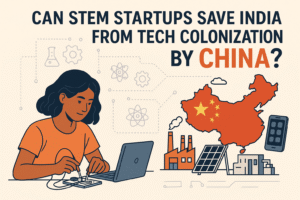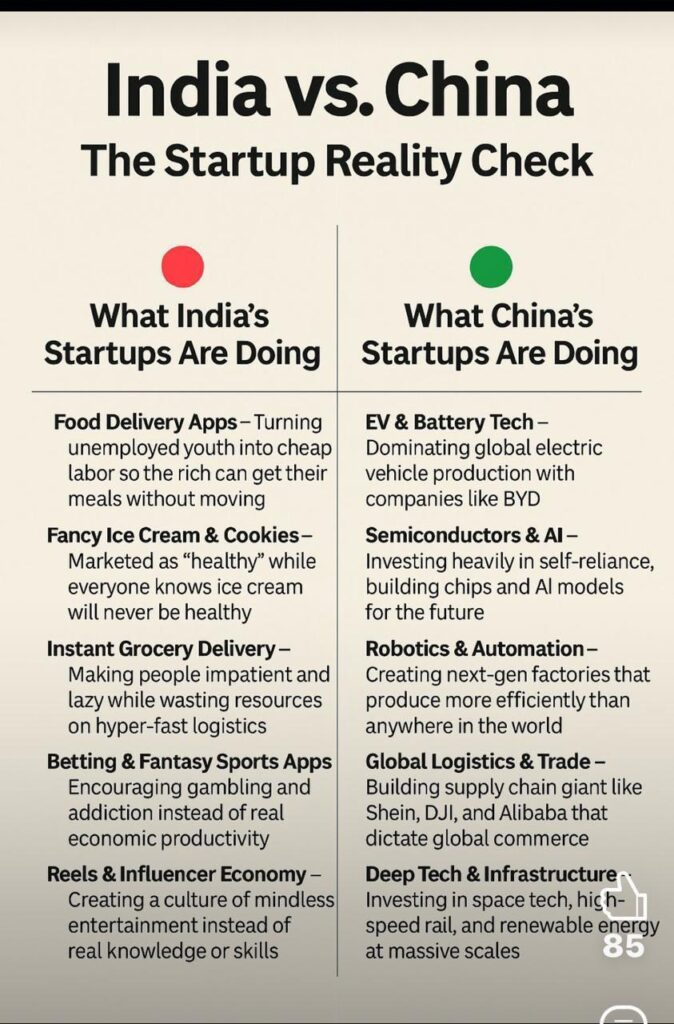In the 21st century, technology is no less than a weapon of influence. Nations that control critical technologies semiconductors, AI, clean energy, robotics control the future economy. India, despite its massive IT workforce and digital economy, still imports the majority of its hardware and components from China. From smartphones to solar panels, India’s dependence on Chinese manufacturing is both a strategic and economic risk.
The question is: How can India avoid being “modern-tech colonized” by China?
The answer might lie in one powerful idea: Building a robust STEM startup culture and ecosystem.
Why STEM Startups Are the Key
STEM—Science, Technology, Engineering, and Mathematics—is the foundation of every modern innovation. Countries like China and the U.S. have invested heavily in STEM education and early-stage startups to dominate global technology. China, in particular, focused on deep-tech manufacturing and youth innovation decades ago, which is why it leads in areas like solar technology, EV batteries, and electronics.
India, on the other hand, has a huge pool of talent but a weak hands-on, product-building culture. Our schools and colleges still focus on theory and exams rather than creating, experimenting, and innovating.
The Root Problem
-
We consume technology but rarely create it.
-
Most students lack exposure to real-world science and engineering challenges.
-
Hardware and deep-tech startups face a lack of infrastructure, funding, and intellectual property (IP) protection.
If we don’t solve this, India risks staying dependent on imports especially from China.
The STEM Startup Solution
Imagine an India where every young student gets to build, break, and innovate.
Where schools have mobile labs, robotics kits, and AI workshops.
Where college students turn ideas into prototypes, and prototypes into startups.
This is where STEM startups and institutions come in. By promoting a maker culture, India can develop homegrown technologies that reduce dependency on imports.
The Role of IP (Intellectual Property) Support
Even if young innovators create something groundbreaking, they often lose ownership because they don’t know how to protect their ideas. IP support is critical.
What Is IP Support?
IP (Intellectual Property) refers to legal rights like patents, copyrights, trademarks, and design protections that safeguard inventions. Without IP:
-
Bigger companies can copy your product.
-
Investors hesitate to fund your idea.
-
Innovations die before reaching the market.
India’s Opportunity
-
Startup India offers up to 80% rebate on patent filing fees.
-
Technology and Innovation Support Centers (TISCs) guide young innovators.
-
Incubators at IITs, IISc, and NITs already provide IP mentorship but we need to scale this nationally.
By integrating IP cells within STEM institutions and startup hubs, we can ensure that every young innovator knows how to protect and scale their ideas.
How STEM Startups Can Outpace China
-
Grassroots Innovation: Start STEM education early, with hands-on labs and IoT/robotics kits in schools.
-
Deep-Tech Focus: Prioritize sectors like semiconductors, clean energy, AI, biotech, and quantum computing.
-
Regional Incubators: Create STEM hubs in Tier-2/3 cities, not just metros.
-
IP-First Approach: Teach startups to protect their ideas with patents, trademarks, and copyrights.
-
Government & Private Partnerships: Companies like Tata, Infosys, and Reliance can provide mentorship, funding, and infrastructure.
Why This Idea Is Correct
-
China succeeded by blending STEM education with startup-driven hardware innovation.
-
India’s young population (65% below age 35) is its biggest strength if we give them tools, not just textbooks.
-
STEM startups are engines of sovereignty. If we control our own tech pipeline, no country including China can dominate us.
The Road Ahead
India is already on the path with programs like Atmanirbhar Bharat and Production Linked Incentives (PLI). But these focus mostly on large industries. The missing link is grassroots STEM entrepreneurship.
A “STEM-for-India” movement focused on early education, startup incubation, and IP protection—could transform India into a creator nation rather than a consumer.


